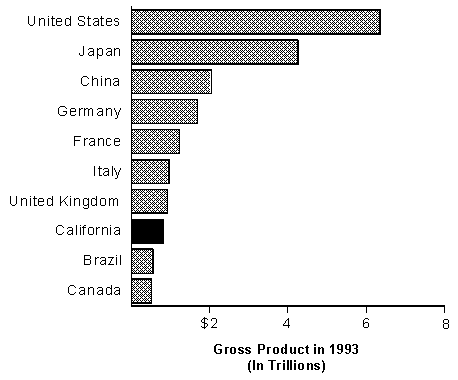
- Despite its recent severe recession, California still ranks among the world's ten largest economies.
- In 1993, its gross product was over $800 billion, making the state's economy larger than all but seven nations.
- California's economy is about one-eighth the size of the U.S., and is about 60 percent larger than the second largest state, New York.
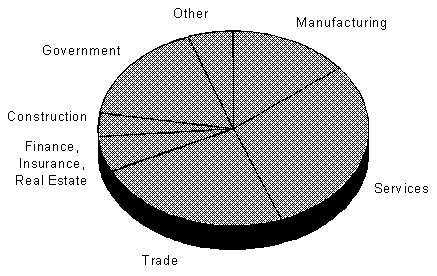
- California has one of the nation's most diversified economies, with employment in over 120 separate industries.
- In terms of broad industry categories, about one-third of the state's employees are in services, one-fourth are in trade, and about one-sixth apiece are in government and manufacturing. The remainder are in construction, finance, insurance, real estate, transportation, utilities, and other industries.
- Diversification has been a positive factor for California, particularly in the past two years. During this period, growth in its varied export, services, trade, and commercial electronics industries has enabled California to overcome the continuing losses in aerospace.
California Wage and Salary Employment
(In Millions)
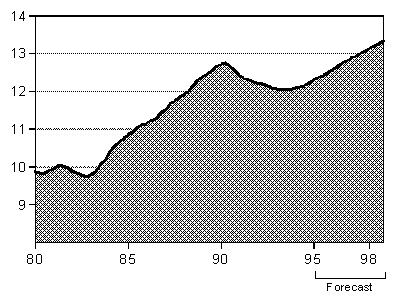
- California's economy, which has traditionally outperformed the nation, fell into a severe recession in mid-1990. The downturn, which was the deepest and most prolonged since the Great Depression, extended into early 1993.
- During this period, the state lost 725,000 jobs, including major declines in the aerospace, construction, retail trade, finance, insurance, and real estate industries.
- The state has been in moderate recovery since mid-1993. Assuming that the current rate of job growth continues, California will have recouped the jobs lost in the recession by the end of 1996.
Job Change From Mid-1993 Through 1995
(In Thousands)
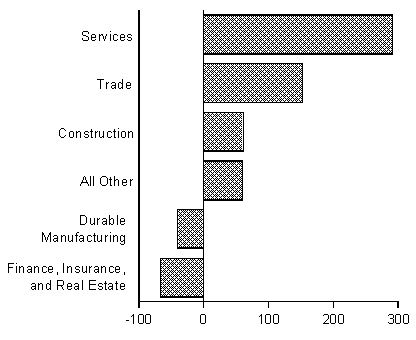
- Virtually all of the net job growth in the current economic recovery has come from the service and trade industries. These two industries added 291,000 and 152,000 jobs, respectively, between mid-1993 and 1995.
- In contrast, two other key industry groups that have increased strongly during past economic recoveries continued to lose jobs during the first two and one-half years of the current economic expansion:
- Durable goods manufacturing has declined because of continued defense-related cutbacks.
- The finance, insurance, and real estate sector also has lost jobs due to ongoing restructuring in the state's banking industry.
Average Yearly Wage (In Thousands)
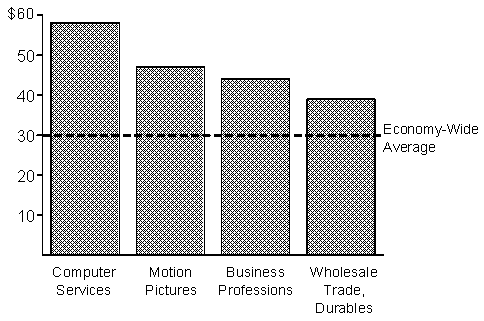
- Most of the new jobs in California's current economic recovery have thus far been in the services and trade industries.
- While many of the new jobs are low wage, many also are high paying. High-paying service jobs include many positions in motion pictures, computer services, and business professions.
- Similarly, a significant number of new jobs in the trade sector have been in wholesale trade involving durable goods. This category, which encompasses import/export firms, has also been relatively high paying.
1994 -- Trade Through California Ports
(In Billions)
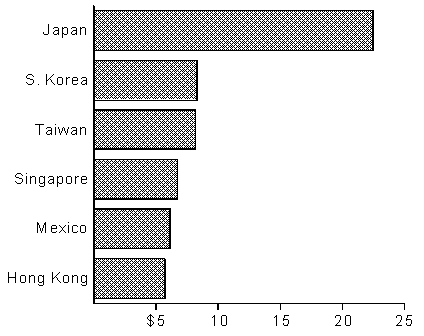
- One of the key factors contributing to California's economic recovery has been international trade. Exports of goods and services produced in California increased 16 percent in 1994, to $81 billion.
- Over the past two years, export growth has bolstered output and employment in a variety of key California industries, including computers, electronics, wholesale trade, agriculture, apparel, and chemicals.
- The majority of California trade is with Pacific Rim countries. Our largest trading partner is Japan, which alone accounts for nearly one-third of all goods passing through California ports.
Jobs (In Thousands)
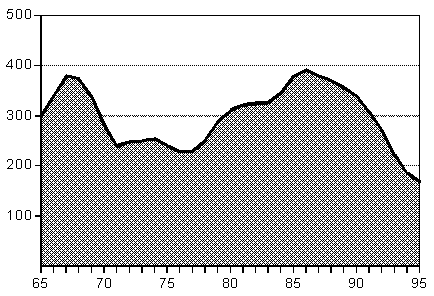
- The aerospace industry, which includes most of California's defense contracting firms, has undergone two major boom-bust cycles in the past 30 years. It expanded during the Vietnam War, contracted sharply in the early 1970s, and grew again during the defense buildup of the 1980s, before declining sharply in the 1990s.
- The most recent decline has been the steepest in California's history. As of 1995, aerospace employment totaled 170,000, or just 43 percent of its 1986 peak.
- On a more positive note, as of the end of 1995, the rate of job losses is subsiding, suggesting that the worst of the cutbacks is over.
Building Permits (In Thousands)
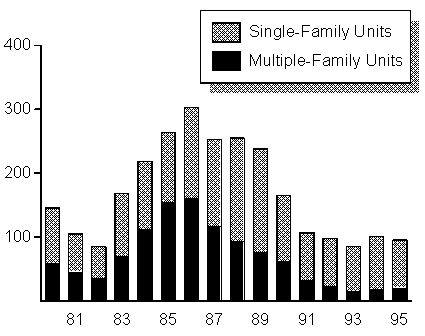
- Housing construction fell sharply in the early 1990s, reflecting such factors as the state's severe recession, past changes in tax laws, and declining home values. Despite an improvement in general economic conditions, home construction remains weak by historical standards.
- Permits for new construction averaged just 95,000 during the 1991 through 1995 period, compared to 210,000 in the 1980s.
- Multi-family construction has been especially soft, partly due to economic factors and partly due to past tax law changes which reduced the investment return on multi-family housing.
 Table
of Contents
Table
of Contents  Part
II, California's Population
Part
II, California's Population
Return to LAO Home Page









